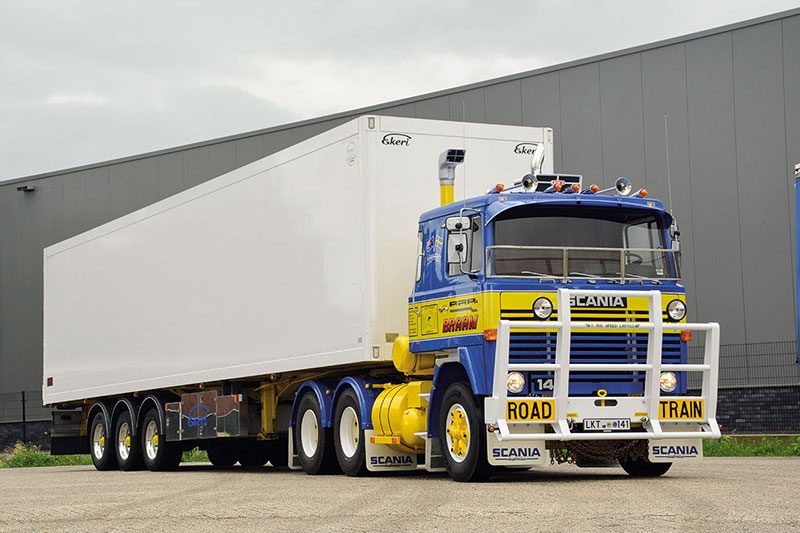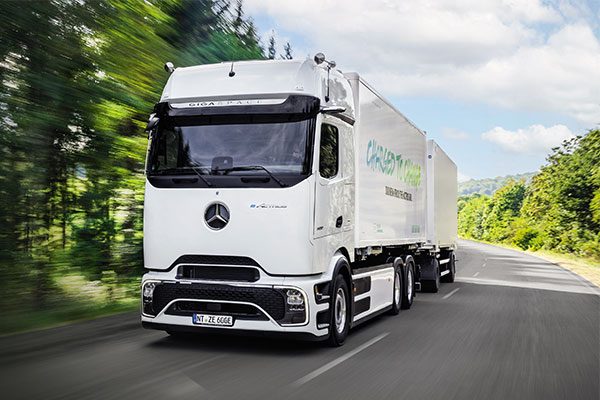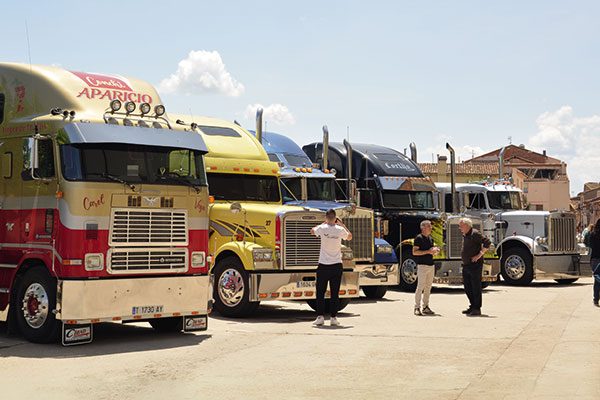INTERNATIONAL TRUCK STOP – Ottmar Behrend Doing it his way
Ottmar Berend appeared in the Just Truckin‘ Around the World section in our July issue last year. The retired international livestock haulier and trailer importer from Germany now deals in trailers and delivers them in his 4×4 MAN. His is a story too good to miss!

Photo: 143 twin-steer with a purebred US spec Wilson trailer.
Sixty-five year old Ottmar Behrend has never owned a yard. “I never felt the need to invest in a yard; I didn‘t want to see them coming back to Jever! All of my work was based further south in foreign countries.” When you realise where Jever is geographically located, right up in the northwest corner of Germany on the edge of the North Sea, you begin to understand his logic. Born in the neighbouring village of Carolinensiel, Ottmar‘s father was a cattle dealer running a small Bedford truck.
After a brief spell buying and selling cattle himself, Ottmar turned his hand to truck driving, for another local cattle dealer. With a desire to work for himself, Ottmar identified a niche in the international transport of live animals. The outgoing young German was on a on the path to becoming one of Europe‘s largest international livestock hauliers. But first he had to choose a truck. Planting the seed for a long relationship with the Scania brand, he bought a secondhand Scania 110 Super 4×2 rigid in 1977, replacing its refrigerated body with a locally built livestock one. After the 110 came a Bussing with an underfloor engine, then a Mercedes-Benz 1632, before returning to the Scania brand, this time a brand new 111.
The late 70s/early 80s were exciting times for the up and coming haulier, who was not deterred by the fact that he did not hold a licence to haul livestock within Germany. To the contrary, it encouraged him to look further afield to emerging markets. “At the time, there was a big demand in France for slaughter horses,” which he says “was the best business ever”. His main customer at the time was VanholsbekéSA, La Gorgue, France. “We did business for ten years, sometimes ten loads per week; they always paid their bill on time too. For such customers we also worked Christmas, New Year‘s Eve and Easter.”
Although transporting horses from Poland to France was a lucrative business (diesel in Poland cost 10 cents per litre then), it was not without its difficulties. One tale he recalls of a driver en-route from Warsaw to Marseille loaded with 22 horses. “The driver had problems with two of the horses lying down in the trailer. Caring for his load, he unloaded the animals and bound five horses at two benches in the parking area on the Dijon to Lyon autoroute. After man and beast had taken a rest, the driver began to load his horses alone in the dark with only a torch. But the horses were gone and so was the bench.” After some searching and help from the Gendarmerie, the horses were safely loaded back onto the truck.

Photo: Fearless, adventurous, and at times maverick; the brotherhood of Behrend drivers.
Heidi, Ottmar‘s wife, took her turn behind the wheel also. “My first time driving a truck was the new Scania 111 on the way to Poland. Ottmar just told me to keep going straight, which I did. As I approached the Polish border, I tried to wake him but he was passed out.”
Ottmar laughs as he picks up the tale: “When I woke up Heidi was in tears as the border was right in front of us and she could not change gears!” Horses weren‘t the only livestock transported. Pigs, sheep, and lambs were also regulars and for this work Ottmar acquired the first 4-deck trailer in Germany, sourced in France and towed by a Mercedes-Benz 1632 tractor. “I drove this truck myself for a while. With any new purchase or innovation,I wanted to see how and if it worked. Then I understand what my drivers are telling me.”
To handle the increasing workload, in 1985 Ottmar established a separate company with a friend, based out of Thessaloniki, Greece, trading under the EURAB banner. Lebanese importers bought lambs from Poland and the DDR (former East Germany), which needed to be moved to the port in Greece for shipment to Lebanon. In the 90s they also shifted more than 25,000 head of pregnant heifers per year from Germany to Turkey by truck and by train. “We had a monopoly from 1986 to 1993 for this type of work,” he says. Further expansion came with the opening of an office in Warsaw in 1990.
As the business grew, so too did the fleet, with Scania being the main brand of choice. Ottmar progressed from his original 110 and 111, up to the 141, 142 and 143 models. “I had the first 143, 6×2 twin-steer tractor in Germany.” As impressive as the top spec trucks were, it was his choice of trailers that really set him apart from others. While on vacation in the US with his family in 1988, Ottmar struck up a conversation with a cattle truck driver. “When he told me the weight of his empty trailer, I immediately became very interested. With my German trailers, the weight of a truck plus trailer was 24 to 26 tonnes, allowing 14 to 16 tonnes payload. With a US trailer it would be 16 tonnes empty, 24 tonnes payload I figured.”With extra productivity at the forefront, Ottmar drove straight to Wilson Trailer Company (WTC) in Sioux City, Iowa, initiating a business relationship with Wilson Persinger, CEO of WTC, something that would continue for the next 15 years.
“To succeed in business, sometimes you have to do something differently from the others. So I began to import Wilson trailers to Germany.” The first one was 100% US design with twin axles set right back at the rear of the trailer, hence the need for a 6×2 Scania. Later, Ottmar would ship BPW axles and brakes to the US so the trailers would meet European standards.

Photo: 1981. Ottmar‘s first 2-deck trailer, a KOPF. You could tip it over, pull back and carry on according to Ottmar.
The big difference between the Wilson trailers and the European ones was the aluminium monocoque construction and no moving floors, eliminating the need for rams. “To me it did not matter, I had one driver, one truck, one trip per week.” The sides were made of pressed aluminium, which Ottmar said was stronger. “The aluminium construction was so light, I couldn‘t lose.”
Ottmar also became the European agent for WTC, selling them outside of Germany to countries such as Poland, Hungary, Romania and Bulgaria, but mostly to Greece. Returning to his choice of trucks, Mercedes-Benz and Renault were also used in the Behrend fleet. “I had the first Renault Magnum V8s in Germany.”
There were initially difficulties with TUV compliance, an obstacle Ottmar negotiated by importing the trucks as secondhand from France, thus needing only a single test in the former DDR. These high spec trucks had been standing at a dealer‘s forecourt in France and were slow to sell. “They had all of the extras, including a Telma retarder. I bought four as I really liked the American look with the set forward front axle.” When asked about reliability, he replies: “The engines were fine, but the gearbox and clutch could not match the power of the V8 engine. There were also problems with the front brake discs melting.” Less glamorous were the trusty Renault Turboliners, which Ottmar says were doing the same job for two-thirds of the price and gave good service.
The company continued to grow, with a branch established in Hungary. To cope with the extra workload, Ottmar took on a number of subcontractors, many of whom towed Behrend trailers. However, as with all businesses, nothing ever stays the same and changes loomed on the horizon. With the disappearance of the Iron Curtain in 1991, Eastern Bloc hauliers entered the market. “They could do the job cheaper than me for sure. Better? I don‘t know.” With the market saturated with cheap competition, Ottmar wound down his livestock haulage operation, concentrating on refrigerated business. “Some of our drivers had been there from the beginning. With good drivers you can still make money, no matter what work.”

Photo: Launched in 1991, the Renault AE500 with a Mack V8 was a revolutionary truck.
The fridge work was conducted within Germany as well as in foreign countries, with double-deck trailers added for the transport of pharmaceuticals. Arguably the most unusual and impressive truck Ottmar owned was the Renault Magnum AE500 rigid and drag fitted with Chereau fridge bodies built in France. This truck delivered hanging meat all over Germany primarily, with occasional ventures into Poland. Like all transport stories there are highs and lows. “My AE with a refrigerated semi trailer was returning empty at night from Koln when the engine stopped. The driver made it to the emergency parking bay on the autobahn and was pumping the fuel hand pump. A sleepy driver in another truck ran into my truck and killed my driver. The truck had already been twice in the garage to find a hairline crack in the fuel line. Eventually, they found it, but too late for him.”
Ottmar is open and frank when he speaks of some of the bad times he experienced in transport, able to add some humour when appropriate, like the time two brothers bought his 1985 Scania, wanting to pay for it by subcontracting. “My mistake,” he recalls. “I accompanied them on their second trip in my French Mercedes 1632 with the four-decker. We loaded sheep in DDR which were to be unloaded in Greece onto a ship bound for Lebanon. Anyway, after loading and into the next morning I was still driving, by now very tired, when suddenly, I came around a corner after Poznan in Poland and the road was full of sheep. My truck with trailer was lying on the side, just a few metres in front of a bus station. When the brothers crawled out of the cab through the broken front screen, they were asked by two Polish guys: ‘Do you have coffee?‘ I had other questions for them. I had to pay more than the value of the sheep for housing them at nearby stables.” Along with the dangers attached to transporting animals on trailers with a high centre of gravity, the trucks also passed through some dangerous regions, such as the Balkans in the late 80s. Backhanders were commonplace, and clever drivers always carried some spirits or cigarettes for tricky situations. Ottmar quotes the old adage of: “Who lubricates well, drives good!”, meaning a liquid gift can get the truck moving quickly again!

Photo: 1991, the first Renault AE Magnum registered on German plates.
In later years, the Behrend trucks were not all painted green. “When running hard, of course you will have some problems with the authorities,” Ottmar adds with a grin. After taking some of the first Scania 144s in factory demonstration mustard, he decided to paint two Mercedes-Benz 1844s in the same shade. “I bought those two Eurocab 1844s from Denmark, unseen in 1996. They were new but had been standing outside for many months with road salt, which had not been washed from the chassis. As I had bought them unseen, I later had to haggle for a reduced price, to pay for painting the chassis. But these were some of the best trucks I owned. The first Actros I bought in 1997 was terrible, however Mercedes paid all of my expenses, even for the higher than promised fuel consumption.” The later Actros Megaspace 1843 MP1, and 1846 MP2 were a much better truck, he claims.
For the first time, DAFs were added to the fleet in 2001. Four Super Space Cab 430s were acquired on a lease with a buyback option at the end of the contract term. “Big mistake. When they were under warranty, they were good and the fuel economy was ok too, but as soon as it expired, everything started to go wrong and they ended up costing me a lot of money.”
The last Behrend truck was sold in 2005, the end of an era. But Ottmar has no regrets. “I have had a great life since I got out of the trucks, travelling all over the world, meeting interesting people. Every year in my home town we have a reunion with my old drivers.” Today Ottmar keeps busy by buying and selling livestock trucks, primarily MAN, Mercedes and DAF. “I travel within a 400km radius of home, buying and selling to clients I know and trust.”
To get his trucking fix, Ottmar relies on his 4×4 MAN camper that he bought new in 2007 and customised to his own design. “I wanted the biggest cab available. They told me I couldn‘t have it, but I got it!” He then added a caravan body and a box behind the caravan for transporting his BMW and KTM motorbikes. “When I drive in the MAN, I feel like I am back in my trucking days.” The MAN is not just for fun. Ottmar often uses it to deliver livestock trailers for his truck dealing business. “I don‘t need a speed limiter as it is officially a camper. Some people on the Autobahn get very annoyed if I pass them with a big livestock trailer at 110kmh,” he laughs. Typical of Ottmar Behrend style, finding a way to do things his own way, even to this day.
200 in 20!
Fulfilling a lifelong dream, in 2017 Ottmar accompanied Paul O‘Callaghan on a run in the Kenworth cattle road train he drove at the time for RTA in the north of Australia. “To see that was something very special, and something I thought I would never see. When I see 220 cattle loaded in 20 minutes, I could not believe it,” said Ottmar.

Photo: Ottmar joined author Paul O‘Callaghan on his day job as a cattle road train driver in the north of Australia in 2017.
Read more
Super Swede
0 Comments11 Minutes
Future Star
0 Comments13 Minutes
Viva Espana!
0 Comments7 Minutes
Beating the odds
0 Comments6 Minutes





